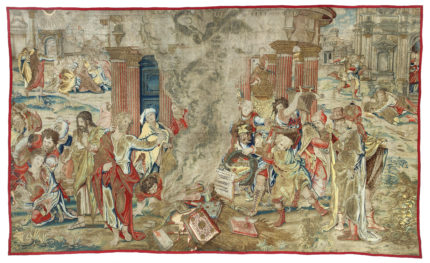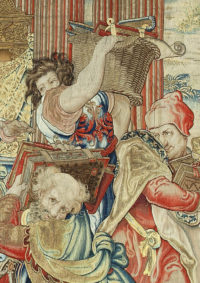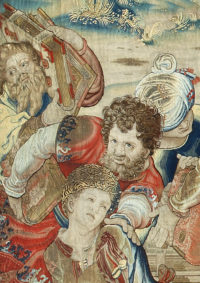A monumental tapestry commissioned by King Henry VIII as part of a set whose whereabouts have been unknown since the 18th century has been found in Spain. The tapestry was one of nine depicting scenes from the life of Saint Paul designed by Flemish master Pieter Coecke van Aelst and woven in his Brussels workshop in the late 1530s. Eighteen feet wide without its original borders and woven with gold and silver threads, the tapestry was of the highest quality available in Europe.

This tapestry is entitled Saint Paul Directing the Burning of the Heathen Books at Ephesus and it shows three episodes from Paul’s visits to Ephesus as reported in Acts of the Apostles. In the upper left Paul converts 12 men of Ephesus and the Holy Spirit descends upon them. In the upper right Paul resurrects Eutychus after he fell asleep during one of Paul’s interminable sermons and fell out of a three story window. The main scene in the center of the tapestry is Paul burning books of magic.
 The Paul series was delivered to Hampton Court between September of 1538 and September of 1539. If those dates ring a bell, they should. That’s when Henry sent out his minions to dissolve the monasteries, take their stuff and destroy what they didn’t take. The tapestry was a big neon sign of support for Henry’s destruction of religious iconography, relics, “erroneous books and Bible translations,” so-called idols, etc. No less a Christian leader than Paul burned books, after all, so clearly the Bible and God were on Henry’s side in his fight to quash ungodly Christian denominations.
The Paul series was delivered to Hampton Court between September of 1538 and September of 1539. If those dates ring a bell, they should. That’s when Henry sent out his minions to dissolve the monasteries, take their stuff and destroy what they didn’t take. The tapestry was a big neon sign of support for Henry’s destruction of religious iconography, relics, “erroneous books and Bible translations,” so-called idols, etc. No less a Christian leader than Paul burned books, after all, so clearly the Bible and God were on Henry’s side in his fight to quash ungodly Christian denominations.
Tapestries were the ultimate artistic displays of wealth in the 16th century. They cost far more to make in materials, artisanship and work hours than paintings of any medium, and when the nobility and aristocracy were the customers, tapestries were literal treasures, made of precious metals, sumptuous fabrics and colored with dyes derived from expensive raw materials. The luxury-loving Henry VIII was an avid tapestry collector and assembled a collection of some 2,500 pieces of exceptional quality. Pieter Coecke van Aelst was one of his favorite designers.
 Only a tiny fraction of that great assemblage is known to have survived. Tapestries went out of fashion in the 18th century and the royal collections were either split up, given away or pilfered or simply fell apart from age. The Paul set were listed in inventories through 1770, after which they disappeared from the historical record. The Burning of the Heathen Books at Ephesus was only known to art historians from a preparatory drawing surviving in Ghent and a fragment of the original cartoon in New York.
Only a tiny fraction of that great assemblage is known to have survived. Tapestries went out of fashion in the 18th century and the royal collections were either split up, given away or pilfered or simply fell apart from age. The Paul set were listed in inventories through 1770, after which they disappeared from the historical record. The Burning of the Heathen Books at Ephesus was only known to art historians from a preparatory drawing surviving in Ghent and a fragment of the original cartoon in New York.
Detective work by leading tapestry experts Simon Franses and Thomas P Campbell has confirmed that this was one of Henry VIII’s commissioned treasures, taken to Spain in the 1960s. Mr Franses described it as “the highest achievement of tapestry weaving”. […]
He added: “The comparable pieces are at Hampton Court, the Abraham tapestries, which Henry VIII owned. But they’re very polite, tame Biblical tapestries, whereas this is a dynamic, energetic piece…It’s absolutely splendid. There’s nothing to touch it in the Victoria & Albert, the Royal Collection or the National Trust.”
Research reveals that a Spanish dealer sold the St Paul tapestry to a Barcelona collector in the 1960s. It was eventually sold to an anonymous buyer in Madrid, who has now sent it to Britain to be cleaned and conserved.
The collector first began to suspect a Hampton Court provenance in 2013. He applied to the Spanish government for an export license but was denied.
Now research has firmly established the link. Franses called on Spain to grant an export licence. He hopes that a UK public collection could then acquire it for considerably less than its value of more than £5m, if it came on the open market.
The tapestry is going on public display for the first time in its long, storied life at Franses in London from October 1st through the 19th. The exhibition, Henry VIII: the Unseen Tapestries, features three other Henrician tapestries, including the Russell Garter Tapestry which is the only surviving tapestry portrait of Henry VIII. On display with the tapestries will be two important textiles from the Tudor period — the silk Armorial Table Carpet of Anne of Cleves’ brother, and the chasuble of Edmund Bonner, chaplain to Wolsey and Henry VIII — that are also on loan to the gallery.